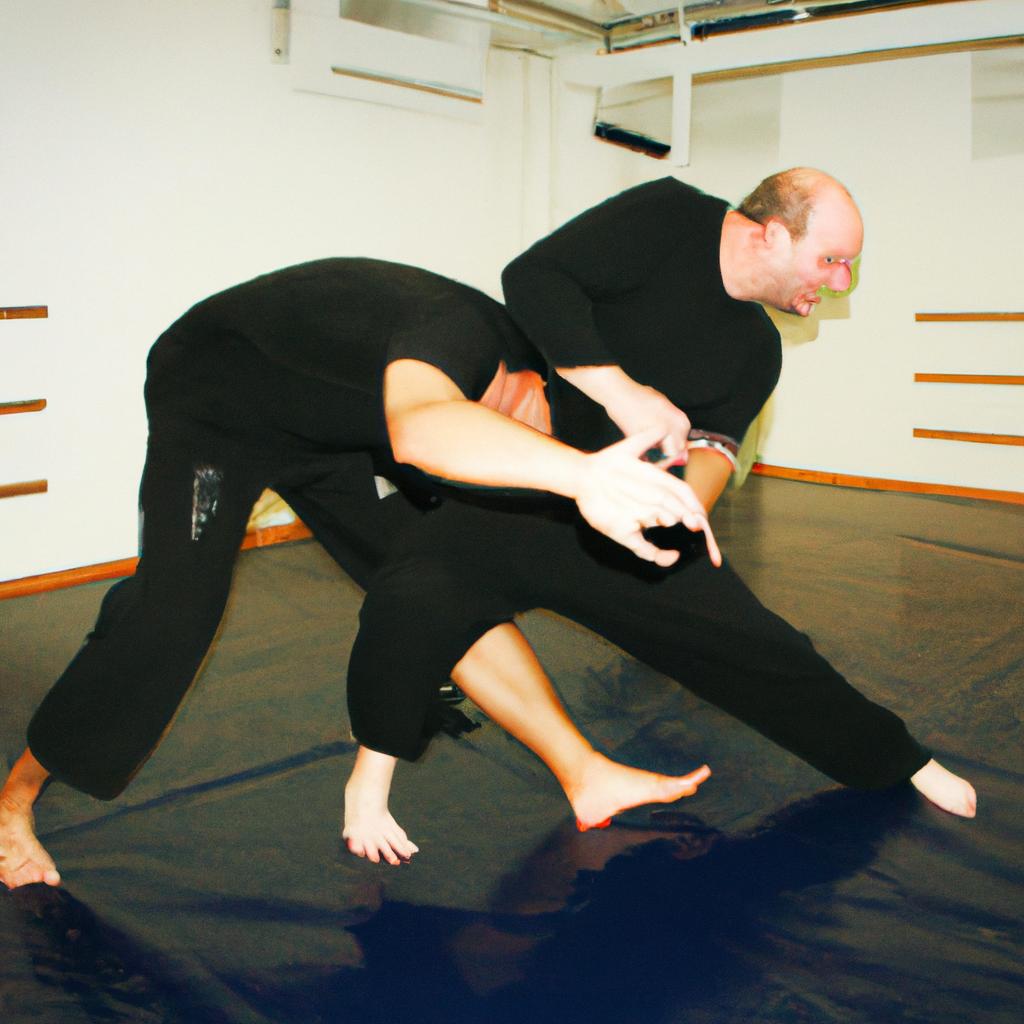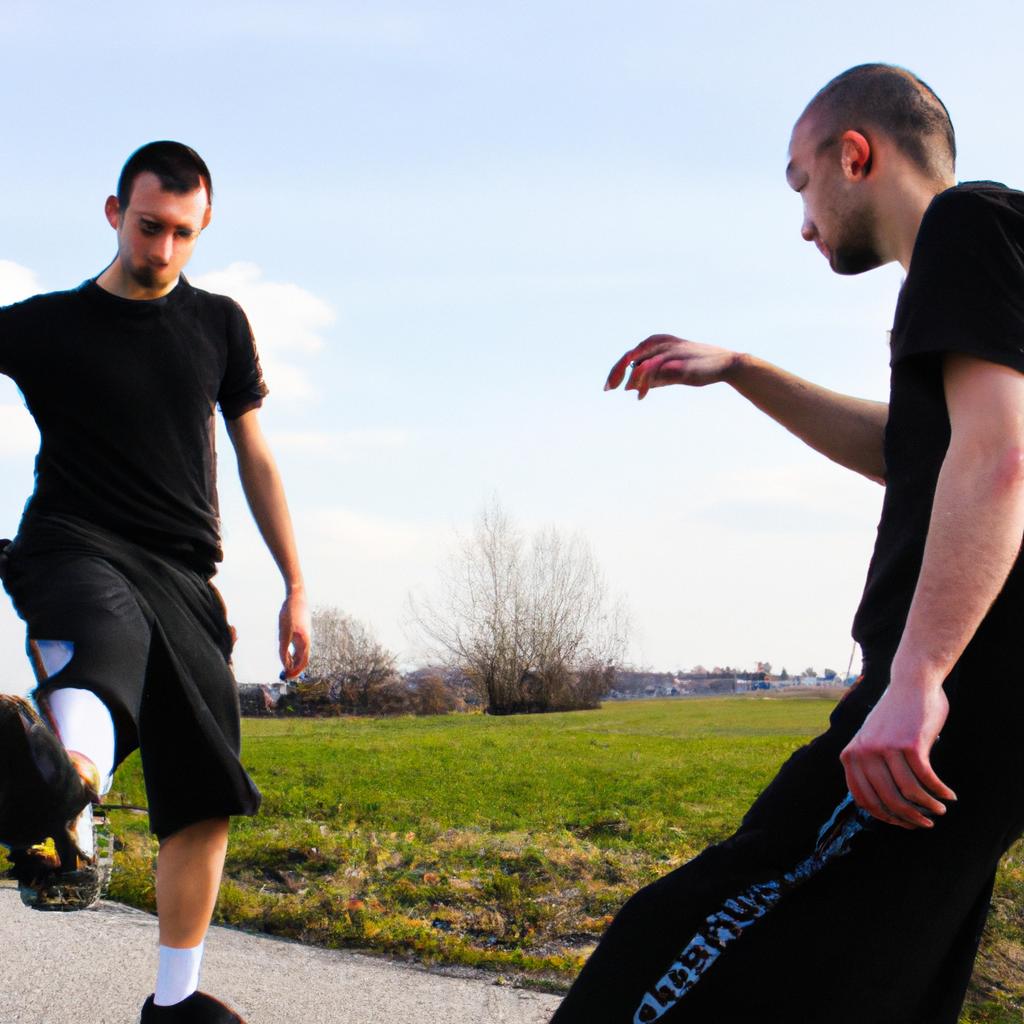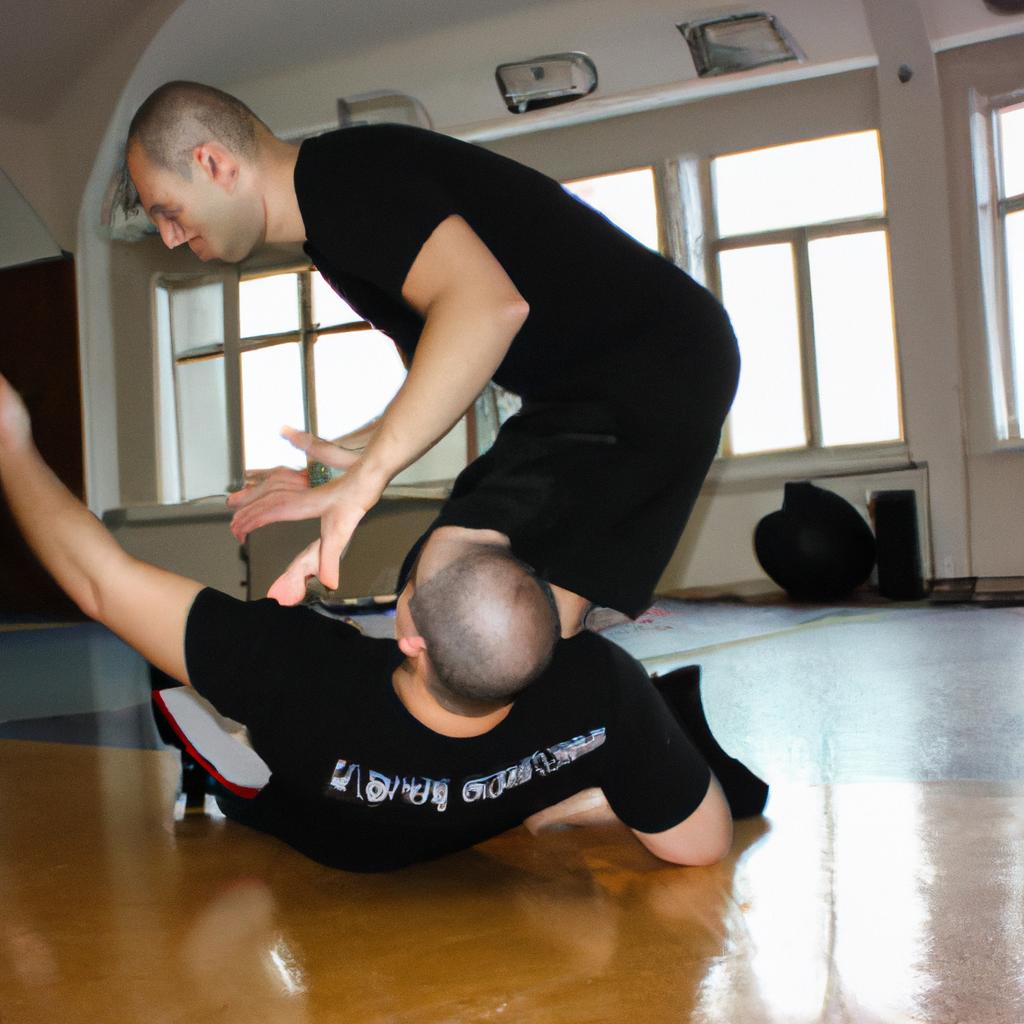Ground fighting in mixed martial arts (MMA) has become an essential aspect of combat sports. As fighters engage in close-quarters combat, the ability to effectively maneuver on the ground and employ various techniques can be a game-changer during fights. For Krav Maga practitioners seeking to enhance their skillset, understanding and incorporating ground fighting moves into their training regimen is crucial for success. This comprehensive guide aims to provide Krav Maga practitioners with a thorough understanding of ground fighting techniques commonly used in MMA, offering insights into both offensive and defensive strategies.
Imagine a hypothetical scenario where a skilled Krav Maga practitioner finds themselves unexpectedly taken down by an opponent during a street altercation. In this moment, the practitioner’s ability to adapt and utilize effective ground fighting moves could mean the difference between victory and defeat. With MMA being one of the most popular forms of competition today, learning how to defend against strikes while on the ground or successfully submit opponents becomes imperative for self-defense purposes as well as competitive endeavors. By exploring key principles, fundamental techniques, and advanced tactics employed by elite MMA athletes specifically tailored for Krav Maga practitioners, this guide will equip individuals with the knowledge necessary to excel in ground fighting situations within the context of their chosen discipline.
Understanding the Importance of Ground Fighting in MMA
Imagine a scenario: two skilled fighters enter an octagon, both proficient in striking and stand-up techniques. The fight begins with a series of powerful punches and kicks exchanged between the opponents. Suddenly, one fighter manages to take their opponent down to the ground using a well-executed takedown technique. This is where ground fighting becomes crucial in Mixed Martial Arts (MMA). It presents a whole new set of challenges and opportunities for fighters to dominate their opponents.
Ground fighting refers to combat situations that occur when at least one participant is on the ground. In MMA, it plays a pivotal role as fights often transition from standing positions to close-quarters grappling on the mat. Understanding its importance can significantly enhance a Krav Maga practitioner’s overall skill set and strategic approach.
The significance of ground fighting lies within several key factors:
- Control: On the ground, fighters have the opportunity to control their opponents’ movements by utilizing various techniques such as holds, submissions, or sweeps.
- Versatility: Ground fighting allows practitioners to employ a wide range of offensive and defensive tactics, including strikes, joint locks, chokes, and positional dominance.
- Strategic Advantage: By effectively engaging in ground fighting, fighters can neutralize their opponents’ strengths while capitalizing on their own skills.
- Transition Mastery: Being adept at transitioning between different positions during ground fighting enables practitioners to maintain advantageous postures or quickly escape unfavorable scenarios.
To demonstrate these points further:
| Advantages | Disadvantages |
|---|---|
| Improved control over opponent | Vulnerability to strikes |
| Greater submission opportunities | Potential difficulty escaping dominant positions |
| Enhanced ability to defend against attacks | Limited mobility and footwork options due to being grounded |
| Increased chance of maintaining top position | Risk of fatigue from prolonged exertion |
In conclusion,
By recognizing the importance of ground fighting in MMA, Krav Maga practitioners can expand their repertoire of techniques and develop a well-rounded skill set. In the subsequent section about “The Basic Principles of Ground Fighting in MMA,” we will explore fundamental principles that underpin successful ground fighting strategies without relying on step-by-step instructions.
The Basic Principles of Ground Fighting in MMA
Consider this scenario: a skilled striker finds themselves taken down to the ground by an opponent during an MMA fight. Suddenly, their usual arsenal of punches and kicks becomes ineffective, leaving them vulnerable and at a disadvantage. This example highlights the critical role that ground fighting plays in mixed martial arts (MMA). To fully comprehend its significance, it is essential to understand various factors related to ground fighting.
Firstly, mastering ground fighting techniques allows fighters to control their opponents effectively. By utilizing grappling maneuvers such as submissions and control holds, fighters can neutralize their adversaries’ striking abilities while positioning themselves for advantageous offensive or defensive moves. This element of control on the ground significantly impacts the outcome of matches and separates competent fighters from those who lack proficiency in this area.
Secondly, understanding the nuances of ground fighting enables practitioners to defend against common attacks from opponents. For instance, being knowledgeable about defending against chokes, joint locks, and strikes while on the ground ensures that fighters are better equipped to protect themselves in potentially dangerous situations. Equipping Krav Maga practitioners with these skills enhances overall self-defense capabilities both inside and outside of the octagon.
Finally, developing expertise in ground fighting provides opportunities for effective counter-attacks and transitions during fights. It allows fighters to seamlessly move from one position to another while maintaining dominance over their opponents. Skilled grapplers possess a range of options when it comes to launching strategic attacks such as sweeps, reversals, submissions or even using their knowledge defensively by escaping unfavorable positions.
To truly appreciate the significance of ground fighting within MMA competitions, consider the following emotional response-inducing bullet points:
- Increased confidence through mastery of grappling techniques
- Enhanced ability to protect oneself from potential harm
- Improved chances of victory through efficient use of counters and transitions
- Heightened sense of accomplishment achieved by becoming well-rounded combatants
Additionally, let us examine how these benefits are further reinforced by the following table:
| Benefits of Ground Fighting in MMA |
|---|
| Control over opponents |
In conclusion, understanding the importance of ground fighting within MMA is pivotal for Krav Maga practitioners aiming to excel in this combat sport. By gaining proficiency in grappling techniques, fighters can establish control over their adversaries, defend against common attacks, and launch effective counter-attacks or transitions. The next section will delve into essential ground fighting techniques specifically tailored for Krav Maga practitioners.
Essential Ground Fighting Techniques for Krav Maga Practitioners
Transitioning seamlessly from the basic principles of ground fighting in MMA, let us now delve into the essential ground fighting techniques that are particularly relevant for Krav Maga practitioners. To illustrate their practical application, consider a hypothetical scenario where an experienced Krav Maga practitioner finds themselves engaged in a ground fight during an MMA match. By employing these techniques effectively, they can gain a significant advantage and increase their chances of success.
To begin with, it is crucial to understand the importance of maintaining control and balance while on the ground. This entails learning how to establish a stable base by spreading one’s weight evenly across multiple points of contact, such as hands, elbows, knees, or shins. Additionally, utilizing effective hip movement becomes paramount when executing various offensive and defensive maneuvers. For instance, using explosive hip thrusts can generate power for strikes or enable quick transitions between positions.
Next, incorporating proper positioning within the grappling exchanges is vital for Krav Maga practitioners seeking to excel in ground fighting scenarios. The mount position allows one fighter to straddle their opponent’s torso while being firmly seated above them—a highly advantageous spot for launching powerful strikes or setting up submissions. On the other hand, understanding how to maintain a solid guard—wherein legs wrap around an opponent’s body—provides opportunities for defense and counterattacks through submission attempts like armbars or triangles.
Furthermore, mastering specific ground fighting techniques necessitates honing both offensive and defensive skills. Notably, developing proficiency in sweeps—an action that involves redirecting an opponent’s weight distribution—can be invaluable for escaping disadvantageous positions and regaining control over the fight. Conversely, having a diverse arsenal of takedowns at one’s disposal enables Krav Maga practitioners to dictate the flow of combat by bringing opponents down to the mat efficiently.
Now imagine this: you find yourself locked in close-quarters combat on the ground against a formidable adversary who seems intent on overpowering you. In such intense moments, knowing the right techniques can make all the difference in turning the tide of battle. Consider these powerful truths that highlight why ground fighting is a crucial aspect of MMA for Krav Maga practitioners:
- Ground fighting demands adaptability and quick thinking.
- Mastery of various positions and transitions provides a strategic advantage.
- Effective use of submissions allows for domination over opponents.
- Solid defensive skills ensure survival and prevent further harm.
In conclusion, understanding the fundamental principles and essential techniques involved in ground fighting serves as an indispensable foundation for Krav Maga practitioners participating in MMA. By maintaining control, employing proper positioning, and developing offensive and defensive skills, they enhance their ability to effectively navigate ground-based confrontations. With this knowledge firmly established, let us now explore the world of effective submission holds for dominating on the ground.
Effective Submission Holds for Dominating on the Ground
Imagine you are a Krav Maga practitioner engaged in ground fighting with an opponent who is skilled at Brazilian Jiu-Jitsu. As the fight progresses, your ability to transition smoothly between different positions becomes crucial for maintaining control and gaining an advantage over your adversary. In this section, we will explore essential techniques that will enable you to master transitions and establish dominant positions on the ground.
One key aspect of effective ground fighting is understanding how to seamlessly move from one position to another while maintaining control. For example, let’s consider a hypothetical situation where you find yourself in your opponent’s guard—a common scenario when facing a trained grappler. To gain dominance, you must utilize proper technique to transition into side control or mount position. By doing so, you not only neutralize potential attacks but also open up opportunities for strikes or submission holds.
To help you further improve your ability to execute smooth transitions during ground fighting encounters, consider the following strategies:
- Maintain constant pressure on your opponent through weight distribution and body positioning.
- Use leverage and timing to exploit openings for transitioning into more advantageous positions.
- Develop fluidity in movements by practicing drills specifically designed for transitioning between various ground fighting positions.
- Study videos or attend workshops led by experienced instructors specializing in grappling arts such as Brazilian Jiu-Jitsu or wrestling.
In addition to these strategies, it can be helpful to understand the significance of each position within a broader context. The table below provides an overview of some commonly encountered positions in ground fighting along with their respective advantages and disadvantages:
| Position | Advantages | Disadvantages |
|---|---|---|
| Mount | Superior striking and submission opportunities | Vulnerability against bucking escapes |
| Side Control | Excellent control and opportunity for submissions | Limited striking options |
| Back Mount | High likelihood of securing rear-naked choke or other submissions | Difficulty in maintaining position if opponent escapes |
| Guard | Ability to control and neutralize opponents’ attacks | Limited striking options |
By familiarizing yourself with these positions, you can better strategize your transitions based on the advantages they offer. Remember, mastering smooth transitions between positions is not only crucial for gaining dominance but also for escaping dangerous situations.
As we delve into the next section about “Escaping from Dangerous Positions in Ground Fighting,” we will explore techniques that will empower you to regain control when caught in disadvantageous positions during ground fighting encounters. Understanding how to escape effectively is just as important as knowing how to transition and establish dominant positions. So let’s continue our journey towards becoming well-rounded Krav Maga practitioners capable of excelling in every aspect of MMA combat.
Escaping from Dangerous Positions in Ground Fighting
Effective Transition:
Continuing our exploration of ground fighting techniques in MMA, let us now delve into the crucial skill of escaping from dangerous positions. To illustrate the importance of these techniques, consider a hypothetical scenario where an experienced Krav Maga practitioner finds themselves being pinned down on the ground by a skilled opponent. In this situation, knowing how to effectively escape can be the difference between victory and defeat.
Escaping from dangerous positions requires a combination of technique, strength, and strategy. Here are some key strategies to keep in mind:
-
Creating space: When trapped underneath an opponent, it is essential to create space and distance to allow for effective movement. Techniques such as bridging or shrimping can help create enough room to maneuver and escape unfavorable positions.
-
Capitalizing on openings: Timing is critical when attempting to escape from dangerous positions. By identifying small windows of opportunity—such as when your opponent momentarily loosens their grip—you can exploit these openings to execute escapes like arm drags or hip switches.
-
Utilizing leverage: Ground fighting relies heavily on leveraging your body weight against your opponent’s movements. Understanding leverage points is vital in executing successful escapes. For instance, using hooks with your legs while simultaneously pushing off with your arms can help you regain control over certain situations.
-
Maintaining composure: In high-pressure situations on the ground, it is easy to panic and make impulsive decisions that may worsen your position further. Remaining calm and composed allows you to think strategically about potential escape routes and increases the likelihood of successfully extricating yourself from precarious scenarios.
To provide a visual aid in understanding these strategies better, refer to the table below that highlights four common dangerous positions along with corresponding recommended escapes:
| Dangerous Position | Recommended Escape |
|---|---|
| Mount | Bridge & Roll |
| Side Control | Shrimp |
| Back Mount | Rear Naked Choke |
| Triangle Choke | Posture Break |
By implementing these strategies and practicing the recommended escapes, Krav Maga practitioners can significantly enhance their ability to overcome dangerous positions on the ground. In our subsequent section, we will explore training drills specifically designed to improve ground fighting skills, providing a practical avenue for further development in this area of MMA proficiency.
Training Drills to Improve Ground Fighting Skills
A crucial aspect of ground fighting in MMA is the ability to transition from defensive positions to offensive ones. This skill allows fighters to seize control of a match and potentially secure victory. To highlight the importance of this technique, let’s consider a hypothetical scenario:
Imagine a fighter finds themselves trapped in an opponent’s guard, struggling to break free while their adversary maintains a dominant position. In order to turn the tide in their favor, our hypothetical fighter must employ effective transitioning techniques.
To successfully transition into offensive positions during ground fighting, practitioners should focus on several key strategies:
- Explosive Power: Developing explosive power through strength training exercises enables fighters to quickly burst out of defensive positions and create openings for offensive maneuvers.
- Timing and Precision: Understanding when and how to execute transitional movements with precision can catch opponents off-guard and provide valuable opportunities for offense.
- Situational Awareness: Being aware of one’s surroundings while grappling on the ground ensures that fighters can identify vulnerabilities in their opponent’s defense and swiftly capitalize on them.
- Versatile Techniques: Learning a diverse range of ground fighting techniques, such as sweeps, reversals, or submissions, equips fighters with multiple options for transitioning into advantageous offensive positions.
In addition to these strategies, structured drills targeting specific aspects of transitioning are essential for honing skills. Here is an example drill that focuses on transitioning from side control to mount position:
| Transition Drill |
|---|
| Start in side control position |
| Execute a hip switch by bridging off your planted foot |
| Slide your knee across your opponent’s belly towards the head |
| Secure the mount position |
By incorporating these drills into regular training sessions, Krav Maga practitioners can enhance their ability to seamlessly move from defensive postures into more favorable attacking positions. The mastery of these transitions not only increases the effectiveness of ground fighting but also boosts a fighter’s confidence and mental resilience.
Successfully transitioning to offensive positions in ground fighting requires a combination of physical prowess, technical proficiency, and strategic thinking. By diligently practicing the strategies outlined above and incorporating targeted drills into their training regimen, Krav Maga practitioners can elevate their ground game and become formidable opponents in MMA competitions or real-life self-defense situations.




